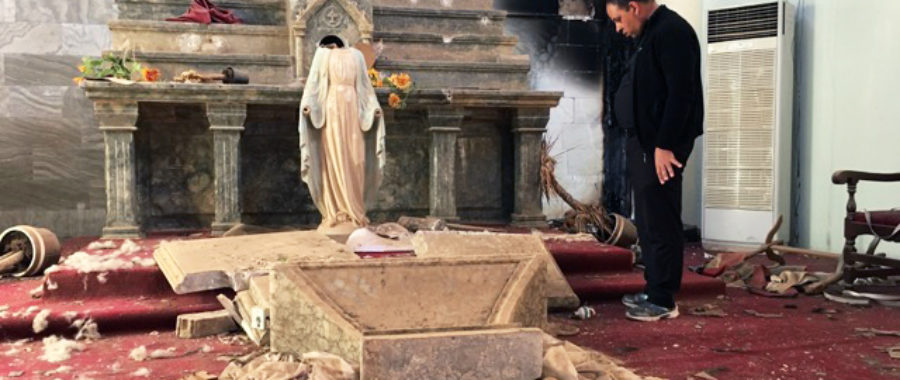
„Zabijemy was wszystkich”
To nie żart. To autentyczny napis odnaleziony przez irackie wojsko w ruinach kościoła w Batnaya, 15 km od Mosulu. Chrześcijanie z Równiny Niniwy wciąż boją się wracać do swoich domów, bo straszy się ich śmiercią. A najgorsze jest to, że w całym tym dramacie biorą udział ludzie z Europy, którzy wspierają tzw. Państwo Islamskie.
Od kilku tygodni trwa ofensywa irackiej armii, której celem jest odbicie Mosulu z rąk islamistycznych terrorystów. Wojska rządowe są wspierane przez odziały peszmergów – kurdyjskich partyzantów, którzy dziś już raczej przypominają regularną armię. Co jakiś czas dochodzą do nas informację o wyzwoleniu kolejnej miejscowości. „Radość z każdego odbitego i ocalonego domu oraz uwolnionego człowieka jest wielka” – mówi jeden z żołnierzy, zagranicznemu korespondentowi wojennemu. I rzeczywiście to prawda, ale niestety częściej można spotykać tam ruiny i śmierć.
Wstrząsające wieści
Kilka dni temu do Papieskiego Stowarzyszenia Pomoc Kościołowi w Potrzebie (PKWP) zostały nadesłane wstrząsające zdjęcia dokumentujące zbrodnie ISIS na ludności chrześcijańskiej. Skala okrucieństwa i nienawiści fundamentalistycznych zbrodniarzy jest wielka. W odbijanych miejscowościach wokół Mosulu co rusz wybuchają małe rebelie, których autorami są członkowie tzw. Państwa Islamskiego, a to z kolei spowalnia działania, których celem jest odbicie Mosulu z rąk terrorystów.
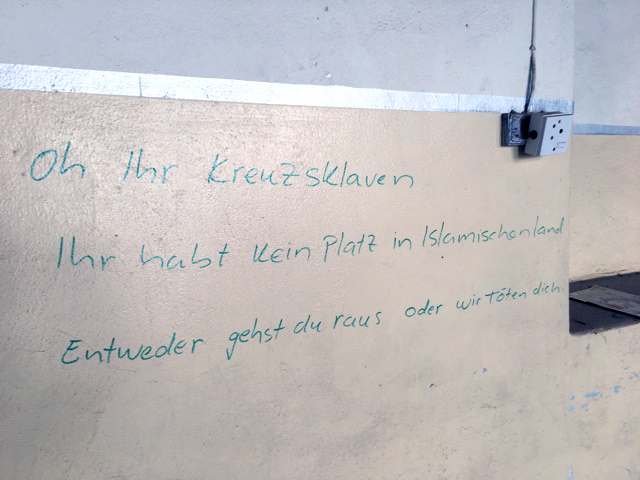
Napis pozostawiony przez członków ISIS w kościele w Batnaya
W ciągłym strachu
Nadesłane materiały fotograficzne są dowodem na to, że w terrorystycznych bojówkach są obecni Europejczycy. W chaldejskim kościele w Batnaya zostało odnalezione graffiti w języku niemieckim: „Niewolnicy krzyża! Ten kraj jest krajem islamskim! Jeśli nie opuścicie go, to zabijemy was wszystkich!”. Skala zniszczeń i strachu jest wielka. „Celem ekstremistów jest wzbudzenie strachu i pokazanie światowej opinii publicznej, kto rządzi w Mosulu czy w całym Iraku” – komentuje Stephen Rashe, prawnik z Irbilu współpracujący z PKWP. „Terroryści doskonale wiedzą, że ich siły słabną, jednak siejąc strach, osiągają swój cel. Ludzie będą się po prostu bać wracać do swoich domów”. Według danych podanych przez ks. Stevena Esama w Batnay żyło około 850 chrześcijańskich rodzin. Spora ich część znajduje się teraz w obozie w Irbilu, jednak wielu z nich zapłaciło życiem.
Na ich ziemi nie może być chrześcijańskich grobów
Islamiści dręczą nie tylko żyjących. W oddalonym o 29 km na południowy wschód od Mosulu miasteczku Karamles doszło do zbeszczeszczania chrześcijańskich grobów. Wycofujące się odziały ISIS zniszczyły domy, w których przed wojną mieszkali chrześcijanie oraz podłożyli ładunki wybuchowe w tamtejszym kościele, z którego pozostały ruiny. Jednak najbardziej niepokoi informacja o profanacji grobu katolickiego księdza, jaka dotarła do PKWP. Stephen Rashe pisze: „grób jednego z naszych kapłanów został odkopany, a zwłoki usunięte. Obok znaleźliśmy jego szaty, w których był pochowany i wieko trumny, ale nie znaleźliśmy jego ciała”.
![Iraq Karamles Burnt Mar Addai church. Karemlash (also spelled Karemles, Karemlish) is an ancient Assyrian town in northern Iraq located less than 18 miles (29 km) south east of Mosul. It is surrounded by many hills that along with it made up the historical Assyrian city of Kar-Mullissi (written URU.kar-dNIN.LÍL), which means "the city of Mullissu" in Akkadian. Residents of the town fled for Iraqi Kurdistan following the invasion of the town by ISIS in August 2014. The town was liberated by Iraqi Security Forces from ISIS rule on October 24, 2016 as part of the larger Battle of Mosul. Population There are between 600 and 650 families in Karemlash. The vast majority of the population is ethnically Assyrian. Historically, the population was mostly part of the Church of the East; however, many converted to Catholicism in the late 18th and early 19th centuries. Today, the inhabitants of Karemlash are mainly members of the Chaldean Catholic Church, but there are also members of the Syriac Orthodox Church and the Assyrian Church of the East. History Karemlash is believed to be among the first human colonies. Hence, it was visited by almost all Mesopotamian archaeologists searching for the ruins of old Assyria and Babylonia. The first person to excavate in the hills of Karemlash was the Englishman Austen Henry Layard in 1846. Many relief sculptures with cuneiform scripts were found in Tel Ghanim and Tel Barbara (two of the hill surrounding Karemlash). On them were found the names of Assyrian Kings of Sargon and Shalmensar. The remains of an Assyrian temple were found at Tel Barbara, and the remains of an Assyrian palace were found at Tel Ghanim. Karemlash lost its important stature during the era of Shalmaneser III (859 – 824 BC), whose son Assur-danin-pal led a rebellion against his father along with another 27 cities. His father empowered his other brother, Shamshi-Adad V, the Governor of Kalah (Nimrud). The civil war lasted for four years, from 827 to 824 BC. With the end of the rebellion, however, Karemlash's neighbor Nimrud did not survive the ravages of the war. Karemlash was so impacted by that rebellion that its people left and it was given the name of "Oro-Karmash", meaning "The Ruined City". Karemlash is still referred to by its Assyrian neighbors as "Karmash". However, Karemlash was reinvigorated during the reigns of Kings Shalmaneser V (726 – 722 BC) and Sargon II (722 – 705 BC), who used it as his temporary capital. The Battle of Karemlash 331 BC This great historical battle between the Greek Alexander of Macedonia and the Persian Emperor Darius III ended with the defeat of the latter and the ushering of the Greek reign over the Near East. Karemlash at the time was called Ko-Komle (which meant in Aramaic "The Camels' Square") after the death of most of the camels of the Persian Emperor Daryos Dara I around the city due to their exhaustion. Hence, historically the Battle of Karamlish is known as the Battle of Ko-Komle. Patriarchal seat of the Church of the East Karemlash was the seat of the Nestorian patriarch Denha II (1336/7–1381/2) for at least part of his reign. The continuator of the Ecclesiastical History of Bar Hebraeus mentions several contacts between Denha II and the Jacobite church in Karamlish between 1358 and 1364. At this period Karemlash had Jacobite and Armenian communities alongside its Nestorian majority, and its village chiefs styled themselves 'emirs'. The prosperity enjoyed by the village during the reign of Denha II presumably came to an end when the patriarchate was relocated to Mosul at an unknown date in the fourteenth or fifteenth century.[2] Karemlash as center of principality During the fourteenth century, Karemlash became the center of a principality, earning it fame. It was mentioned in several books as a trade center of immense importance. Among some of the governors during this period were: 1. Prince Masoud (1317) 2. Prince Nasser El-Deen 3. Prince Hassan (1358) 4. Prince Matti (brother of Prince Hassan) 5. Prince Beyazeed (1364) 6. Prince Sahab Masoud (end of 14th century) The destruction by Nader Shah During the wars between the Persian and Ottoman Empires, Nader Shah of Persia decided in 1732 to attack and occupy Mesopotamia. After occupying Baghdad the same year, he sent a small part of his army (8,000 soldiers strong) to occupy Nineveh and its surroundings. However, his army was defeated. This angered Nader Shah, who decided in 1743 to go himself with 300,000 soldiers and 390 cannons. After occupying Kirkuk and Erbil, he moved to Nineveh and its villages. He decided to bomb Karemlash before entering it. Most of the houses of the village were ruined, in addition to Mar Yohanan Church and Beth Sahda "Church of the Forty Martyrs". Nader Shah stayed in Karemlash for four days. It was estimated that over 4,000 Assyrian Christians were massacred during those four days. Churches and monasteries Historians kept the memories of many churches and monasteries of the Church of the East (Nestorian) in Karemlash intact. These ancient churches include the monasteries of Mar Giwargis (St. George), Mar Yonan (St. Jonah), Mar Youkhanna (St. John), and Dair Banat Maryam (the Monastery of St. Mary's Daughters). The last two have long been forgotten; meanwhile, Mar Yonan became the grounds of a school in the early twentieth century. Below is a list of the known monasteries and churches in Karemlash: Mar Giwargis Monastery • Mar Giwargis Monastery – This Monastery was built in the northern parts of town by a monk named Giwargis in late sixth century. It continues to stand today. However, it is believed that it was turned into a cemetery after the Mongols invasion. • Mar Yonan Monastery – A monk named Yonan built this monastery in the seventh century. The monastery is mentioned in an unidentified Nestorian writer's fourteenth-century manuscript. It is believed that it was abandoned after the invasion of Nadir Shah in 1743. • Mar Youkhanna Monastery – There is nothing left of this monastery but a small hill known as the hill of monk Youkhanna (Tell rabban Youkhanna) situated in the southern parts of town. It was mentioned in A.D. 660 in the manuscript of Bar'aeeta, and it was populous in 1736 according to the manuscript of kitab dafanat al-Mowta (the book of the hidden treasures of the dead). It was destroyed completely during the invasion of Persian Nadir Shah on August 15, 1743. • Dair Banat Maryam – It was attached to Mar Giwargis Monastery and served as a monastery for the nuns. The monastery suffered tremendously at the hands of the Mongols in the thirteenth century and in the eighteenth century at the hands of Kurdish Ismail Pasha of Rawandos. It was referred to by Charles Watson Bradt during his visit to Karemlash on June 2, 1758. • The Church of the Forty Martyrs – The remains of this church are situated on a hill known as Beth Sahde (the Martyrs Home) southeast of the town. It was standing in 1236, when Karemlash was attacked by the Mongols. It was destroyed by Nadir Shah in 1743. • St. Barbara Church – The church is situated on the ruins of a hill by the same name west of town. It was built on the ruins of an ancient Assyrian temple for the god Banu. Excavations at the hill in 1852 uncovered two halls used by ancient Assyrians in their religious ceremonies as well as tools that were used during worship. The earth soil covers a ziggurat that was built by ancient Assyrians to serve as a temple. Barbara was the daughter of the pagan governor of the region. She converted to Christianity, with her servant Yulina, against the will of her father who imprisoned her. When they refused to change their mind and denounce Christianity, the pagan governor ordered their death. They were killed in a room attached to the temple, where the church stands today. The church was attacked by Nadir Shah; however, the residents renovated and rebuilt it in 1798. • The Church of the Virgin – The church is situated in the center of town. It is a small, but beautiful church. It was once the home of a lady who donated it to the public. It was established as a church in 1887 and enlarged in 1902. • Mar Addai Church Mar Addai Church – The church is situated in the northern parts of town. It is currently the biggest and most modern church in Karemlash. Construction began in 1937 and, after some delays, it was consecrated in 1963. Post Iraq War Karemlash has been relatively calm following the US-led Iraq War. In late 2003, the town came briefly under the control of the 101st Airborne Division (377th Parachute Field Artillery Battalion). The town has shown strong support towards the Assyrian Democratic Movement during the parliamentary and local elections in 2005, 2007 and 2010. The town has also received thousands of Assyrian and other Christian refugees from other parts of the country after recent waves of violence against them. In response to this influx of refugees, Sarkis Aghajan and the Supreme committee of Christian affairs built and renovated new homes, churches, cemeteries, infrastructure and a complex for Armenian Refugees, among other improvements. On August 6, 2014, Islamic State of Iraq and Syria took over the town, leading to all of its inhabitants fleeing to Erbil. The region is still controlled by ISIS, and during their occupation of the city they burned an 80-year-old Assyrian woman to death for "failing to comply with the strict laws of the Islamic State.", and destroyed a large portion of the Historic Mar Behnam Monastery. On October 24, 2016, the city was liberated by the Iraqi Army, which, on the same day, returned crosses on the dome of some of the main churches.](https://misyjne.pl/wp-content/uploads/2016/11/ACN-20161115-48215.jpg)
Zniszczony kościół w Karamles
Kto za to zapłaci?
To, co się dzieje w Iraku, to istne szaleństwo: ludobójstwa, prześladowania, handel ludźmi, bezczeszczenie świątyń. To wszystko dzieje się za cichym przyzwoleniem wielkich tego świata, którzy w tym regionie postanowili pozałatwiać swoje naftowe interesy. Kto weźmie odpowiedzialność, za to co się tam teraz dzieje? Kto stanie na wysokości zadania i spróbuje „jakoś” – szczególnie podkreślam „jakoś”, bo na pewno nie da się tego zła naprawić w 100 % – naprawić wyrządzone krzywdy zwykłym ludziom, którzy są Bogu ducha winni?
ks. Paweł Kucia
foto. PKWP
Wybrane dla Ciebie
Czytałeś? Wesprzyj nas!
Działamy także dzięki Waszej pomocy. Wesprzyj działalność ewangelizacyjną naszej redakcji!
| Zobacz także |
| Wasze komentarze |










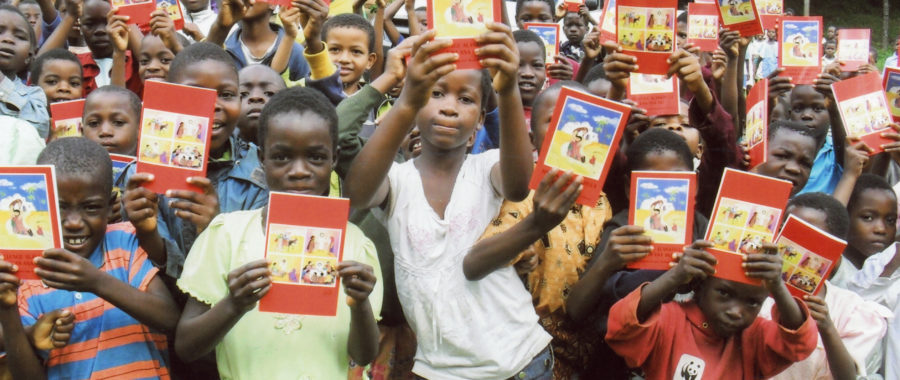
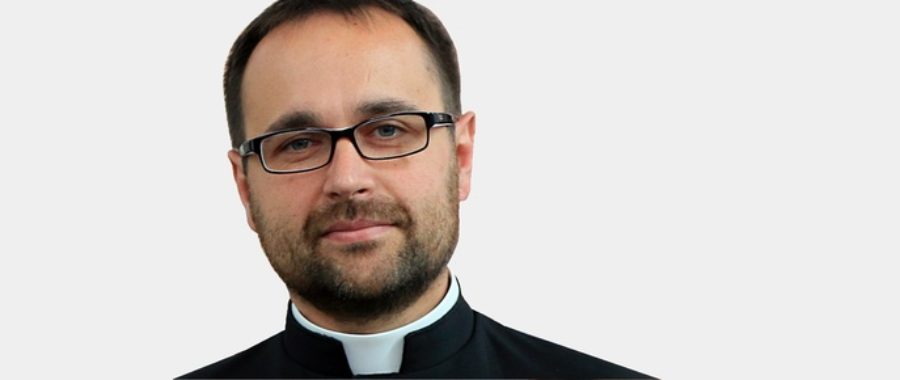

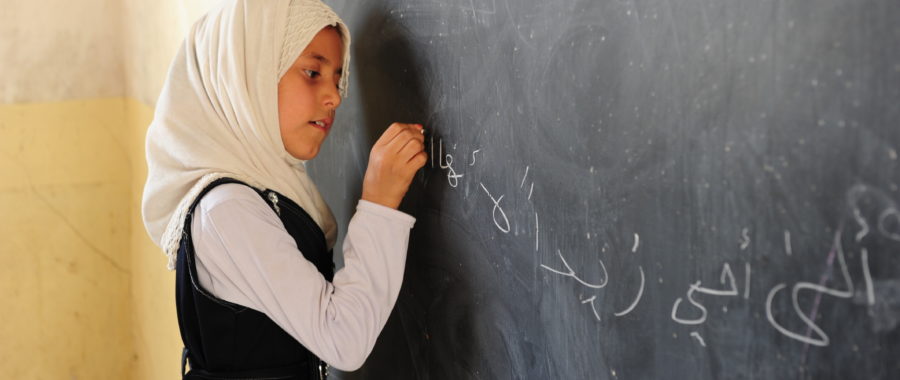
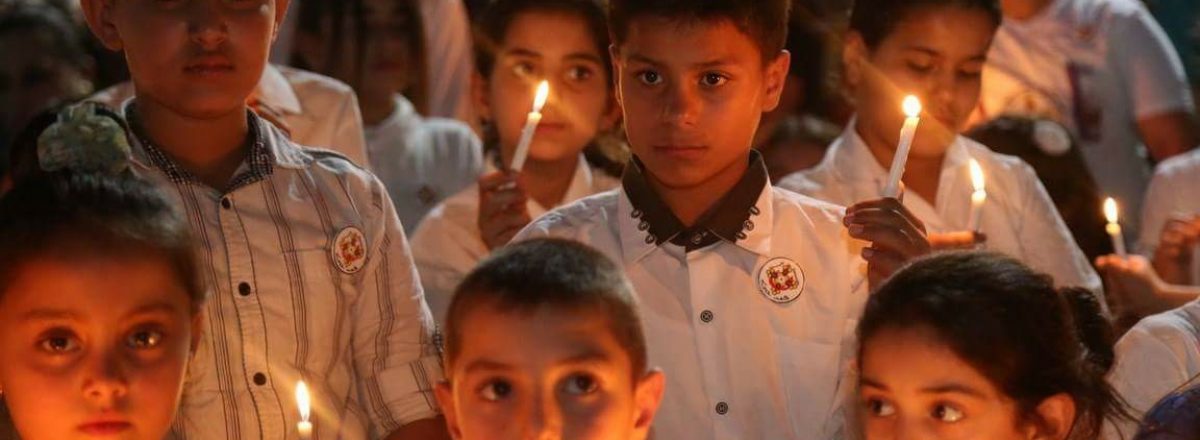
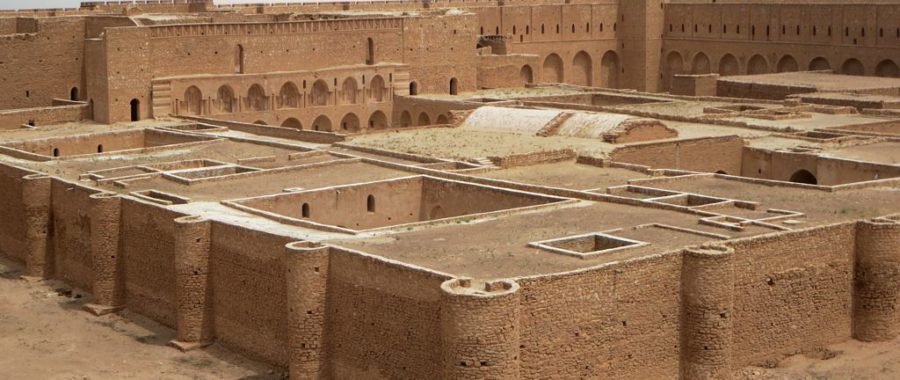

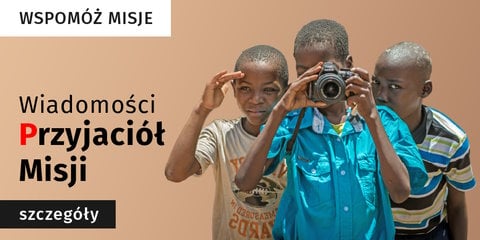
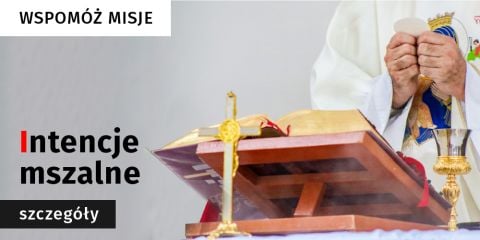


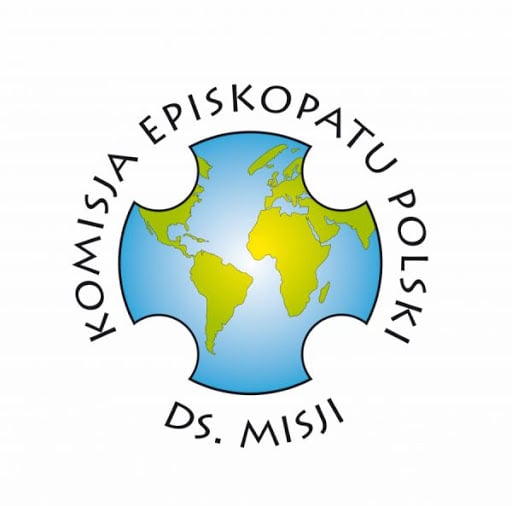



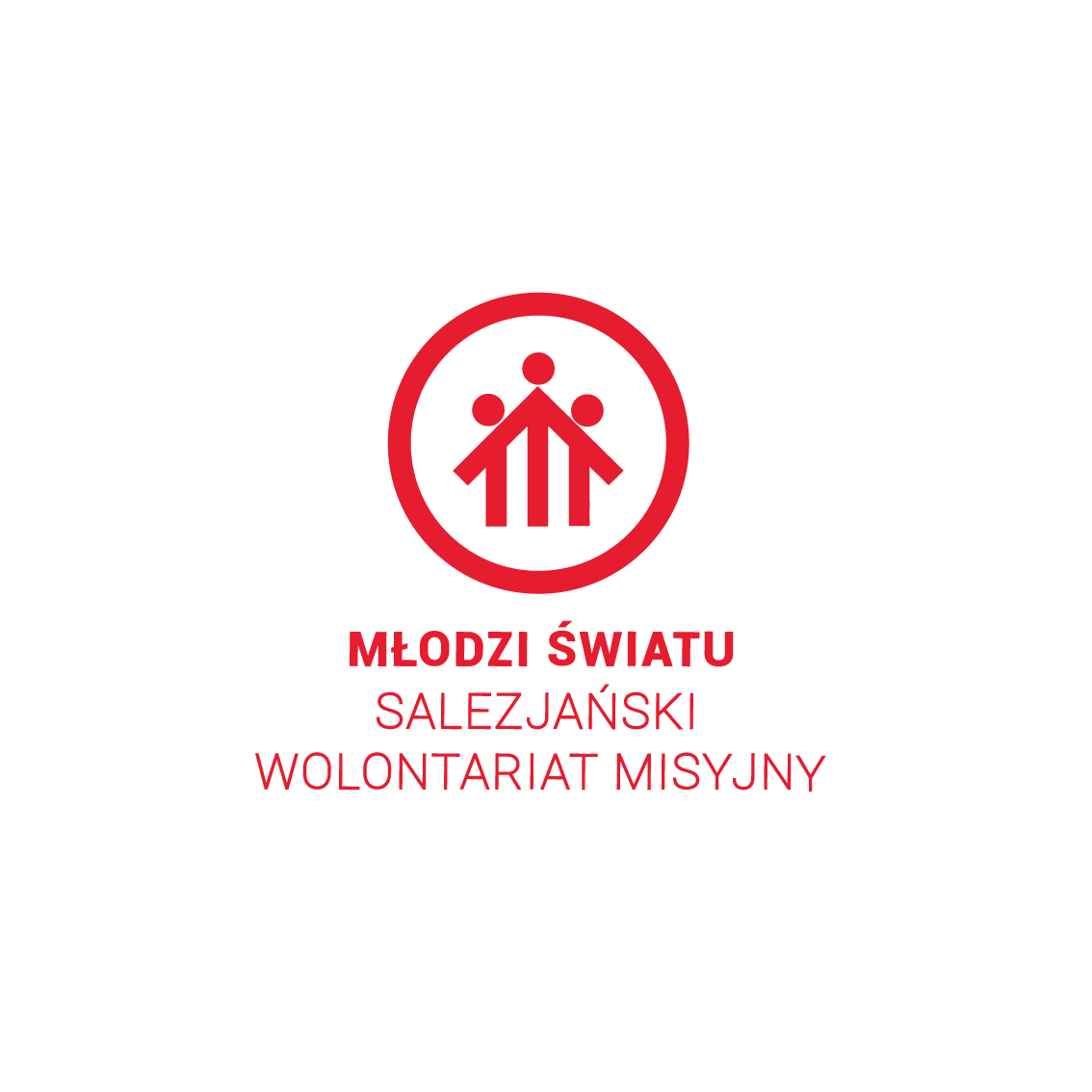





 Wiadomości
Wiadomości Wideo
Wideo Modlitwy
Modlitwy Sklep
Sklep Kalendarz liturgiczny
Kalendarz liturgiczny